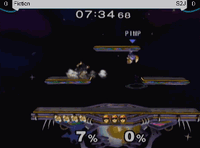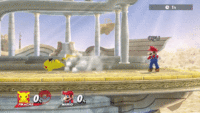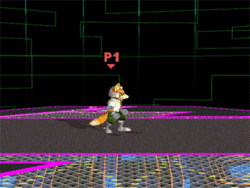Dash-dance: Difference between revisions
(→In Super Smash Bros. Brawl: Made changes to correct slightly misleading information.) |
No edit summary |
||
| Line 15: | Line 15: | ||
===In ''[[Super Smash Bros. Brawl]]''=== | ===In ''[[Super Smash Bros. Brawl]]''=== | ||
In ''Brawl'', dash-dancing is more difficult to perform, as | In ''Brawl'', dash-dancing is more difficult to perform, as every character now has a short initial dash animation, and the window for reverse dashes ceases before the animation completes, making it problematic to do consistently. In addition, many throws have increased knockback, which, coupled with ''Brawl's'' [[hitstun|hitstun cancelling]], makes [[tech]]-chasing more difficult. Random [[tripping]] also interrupts dash-dancing, leaving the player vulnerable should it occur. As a result of these changes, dash-dancing is considerably less useful than it was in ''Melee'' and therefore sees little use in competitive play. The technique, however, is important in {{SSBB|Sonic}}'s [[metagame]], as it heavily relies on mindgames and [[punishment]] to garner KOs. | ||
===In ''[[Super Smash Bros. 4]]''=== | ===In ''[[Super Smash Bros. 4]]''=== | ||
[[File:Extendeddashdance.gif|thumb|right|{{SSB4|Pikachu}} performing an extended dash-dance in ''SSB4'']] | [[File:Extendeddashdance.gif|thumb|right|{{SSB4|Pikachu}} performing an extended dash-dance in ''SSB4'']] | ||
In ''Super Smash Bros. 4'', the removal of random tripping allows safer dash-dances than in ''Brawl''. | In ''Super Smash Bros. 4'', the removal of random tripping allows safer dash-dances than in ''Brawl''. However, no changes have been made to the length of initial dash animations or the reverse dash window; thus, dash-dances are still difficult to perform as in ''Brawl'' and the technique again sees very little use in competitive play. | ||
To compensate for its continued ineffectiveness, a number of competitive players perform a very similar technique known as '''extended dash-dancing'''. This maneuver combines [[fox-trotting]] and dash-dancing: the player inputs a dash and returns the control stick to a neutral position, and then inputs another dash in the same direction and quickly flicks the control stick in the opposite direction, which causes the character to change directions without going into their turn-around animation. The timing for this varies depending on | To compensate for its continued ineffectiveness, a number of competitive players perform a very similar technique known as '''extended dash-dancing'''. This maneuver combines [[fox-trotting]] and dash-dancing: the player inputs a dash and returns the control stick to a neutral position, and then inputs another dash in the same direction and quickly flicks the control stick in the opposite direction, which causes the character to change directions without going into their turn-around animation. The timing for this varies depending on each character's fox-trot window. Some characters, such as {{SSB4|Cloud}} and {{SSB4|Lucario}}, gain very little benefit from extended dash-dancing, as they can simply fox-trot in alternating directions for nearly identical results without any extra effort, due to the lenient turn-around window in their initial dash. Other characters, including Lucario, {{SSB4|Bowser}}, {{SSB4|Charizard}}, and {{SSB4|Ganondorf}}, have short skidding animations after their run, so they can quickly perform dashes in the other direction after letting go of their run, giving them more options outside of extended dash-dancing. | ||
In terms of appearance, extended dash-dancing is slower than dash-dancing in ''Melee''; this makes it less versatile while being more difficult to perform due to more frequent inputs and tighter timings, but it is still a useful technique worth considering for players to make the most of their character's mobility. | In terms of appearance, extended dash-dancing is slower than dash-dancing in ''Melee''; this makes it less versatile while being more difficult to perform due to more frequent inputs and tighter timings, but it is still a useful technique worth considering for players to make the most of their character's mobility. | ||
Revision as of 18:44, April 16, 2016
The dash-dance is an advanced technique in the Super Smash Bros. games. Performed by rapidly tapping the analog stick left and right while on the ground, it cancels out the character's initial dashing animation with another animation in the opposite direction, causing the character to quickly and repeatedly dash to the right and left in a short distance.
The time window in which a character can dash and then change directions by dash-dancing matches the amount of frames in their initial dash animation. After they complete their initial dashing animation, they'll transition to their standard dashing animation; at this point, tapping the analog stick in the opposite direction will cause the character to enter their turnaround animation, during which no attacks can be performed.
In competitive play
In Super Smash Bros.
In the original Super Smash Bros., dash-dancing takes longer to perform, because no matter how fast it is performed, there is a small turnaround animation (except for Captain Falcon), making the maneuver a bit less useful than in Melee. This does however make it a lot easier to Pivot than in Melee.
In Super Smash Bros. Melee

While dash-dancing can be performed in all four games, it sees most of its use in Melee. In Melee, dash-dancing is used primarily to play spacing mindgames with the opponent. By continuously switching directions, the player can confuse opponents in regards to their approach, as they can potentially either backtrack or approach while dash-dancing; in addition, it can also cause opponents to attempt an attack in the dash-forward animation, only for the player to dash backwards and quickly punish the end lag of such attacks by doubling-back. As players can also jump out of a dash-dance, it can allow players to quickly use SHFFLs and wavedashes. Dash-dancing can also be used in conjunction with low-knockback throws to perform tech-chases, as the action allows players to quickly run in either direction, allowing for quick pursuit of rolling opponents. Characters with long dashing animations, such as Fox, Marth, and Captain Falcon, make the most use of the technique, and proper use of dash-dancing is important in all of their respective metagames. Sheik has the shortest dash, making dash-dances harder to perform, though this also gives her a faster crouch cancel out of her run in return.
In Super Smash Bros. Brawl
In Brawl, dash-dancing is more difficult to perform, as every character now has a short initial dash animation, and the window for reverse dashes ceases before the animation completes, making it problematic to do consistently. In addition, many throws have increased knockback, which, coupled with Brawl's hitstun cancelling, makes tech-chasing more difficult. Random tripping also interrupts dash-dancing, leaving the player vulnerable should it occur. As a result of these changes, dash-dancing is considerably less useful than it was in Melee and therefore sees little use in competitive play. The technique, however, is important in Sonic's metagame, as it heavily relies on mindgames and punishment to garner KOs.
In Super Smash Bros. 4

In Super Smash Bros. 4, the removal of random tripping allows safer dash-dances than in Brawl. However, no changes have been made to the length of initial dash animations or the reverse dash window; thus, dash-dances are still difficult to perform as in Brawl and the technique again sees very little use in competitive play.
To compensate for its continued ineffectiveness, a number of competitive players perform a very similar technique known as extended dash-dancing. This maneuver combines fox-trotting and dash-dancing: the player inputs a dash and returns the control stick to a neutral position, and then inputs another dash in the same direction and quickly flicks the control stick in the opposite direction, which causes the character to change directions without going into their turn-around animation. The timing for this varies depending on each character's fox-trot window. Some characters, such as Cloud and Lucario, gain very little benefit from extended dash-dancing, as they can simply fox-trot in alternating directions for nearly identical results without any extra effort, due to the lenient turn-around window in their initial dash. Other characters, including Lucario, Bowser, Charizard, and Ganondorf, have short skidding animations after their run, so they can quickly perform dashes in the other direction after letting go of their run, giving them more options outside of extended dash-dancing.
In terms of appearance, extended dash-dancing is slower than dash-dancing in Melee; this makes it less versatile while being more difficult to perform due to more frequent inputs and tighter timings, but it is still a useful technique worth considering for players to make the most of their character's mobility.

